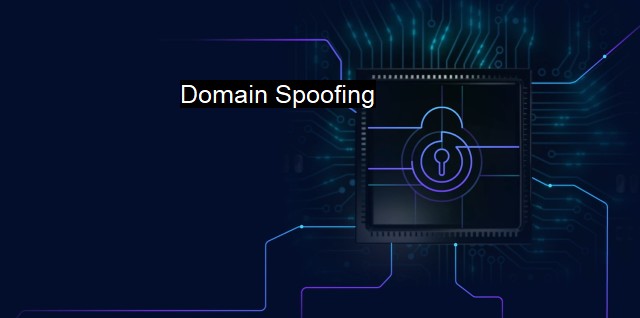What is Domain Spoofing?
The Deceptive Tactics of Domain Spoofing: Recognizing and Protecting Against Cybercriminals' Attacks
Domain spoofing is a deceptive practice employed by hackers and cybercriminals, within the broader context of cybersecurity and antivirus measures. It represents one of many dangers in the vast world of internet malfeasance, with its roots traced back to the advent of email communications and domain name system operations.To understand domain spoofing, one must first understand what a domain is. A domain, or more specifically a domain name, is a human-readable version of an internet address. Normally, internet addresses are long strings of numbers, but domain names simplify those addresses into a more memorable format.
Domain spoofing is when malicious individuals or entities manipulate domain names so that they appear to be representing another person's or organization's domain name. The goal is to mislead recipients or users about the identity of the sender or the site they are connecting to, usually with malicious intent such as phishing attempts or malware spreading.
Historically, spoofing was largely an email-based concern. An attacker would falsify either the “From” email address field or the email’s “Return-Path” so that at first glance, the email would appear to originate from a known or credible source rather than the attacker. While this method is still being used, modern-day domain spoofing has expanded into the world of website interaction, affecting the very internet architecture supporting digital communications.
As cybercriminals become more sophisticated, they have learned to leverage weaknesses in the domain name system (DNS) to manipulate or ‘spoof’ DNS cache data. This makes a user’s system believe it is genuinely accessing a trusted website when in reality, it is a ‘spoof’ designed to harvest sensitive personal information, coax users into performing certain actions, download malicious code, and further exposing the system to a myriad of cybersecurity threats.
To protect against domain spoofing, multiple measures can be taken under cybersecurity and antivirus applications. As a base measure, organizations should maintain up-to-date DNS records, using domain-based email solutions that authenticate and validate email sources. SPF (Sender Policy Framework), DKIM (DomainKeys Identified Mail), and DMARC (Domain-based Message Authentication, Reporting, and Conformance) are tools commonly used to validate a domain’s authenticity.
Beyond this, web server certificates can also help users ensure they are connecting to the genuine server. Browser-based warnings upon detecting unusual or unverified certificates can also serve as an effective deterrent against domain spoofing and mitigating the potential mishaps it brings. It’s equally important for organizations to train their staff to recognize potential domain spoofing attempts.
More complex antivirus solutions also combat domain spoofing. By scanning for malicious code disguised within what appears to be innocent applications or downloads, antivirus software aids in the fight against spoofing-based malware.
Domain spoofing is a significant cybersecurity issue driven by the misuse of familiar domain names, with the intention to mislead individuals or systems to achieve harmful objectives. Trojans, worms, ransomware, spyware, and phishing are some of the common threats associated with this scheme. Hence, making it necessary for individuals and organizations to take adequate cybersecurity measures to safeguard against this malicious technique. With the growing sophistication in domain spoofing and ever-evolving cybersecurity threats, remaining vigilant and keeping your cybersecurity strategy updated is no longer a luxury, it's a necessity.

Domain Spoofing FAQs
What is domain spoofing?
Domain spoofing is a cyber attack where an attacker creates a fake domain that looks similar to a legitimate one. The goal is to trick people into thinking they are communicating with a trusted source when in reality, they are interacting with a malicious entity.What are the risks of domain spoofing?
The risks of domain spoofing include the theft of sensitive information, malware infections, and financial loss. Attackers can use spoofed domains to trick users into entering their login credentials, downloading malware, or making payments to fake accounts.How can I prevent domain spoofing attacks?
To prevent domain spoofing attacks, you should always verify the source of any email, link, or message that requests personal or financial information. Look for signs of phishing or spoofing, such as misspelled domains, suspicious URLs, and unusual request patterns. You can also use antivirus software that detects and blocks known spoofing techniques.What should I do if I suspect a domain spoofing attack?
If you suspect a domain spoofing attack, you should report it to your IT department or security team immediately. They can investigate the source of the attack, block the malicious domains, and take steps to prevent similar attacks in the future. You should also avoid clicking on any suspicious links or downloading any files from untrusted sources until the issue has been resolved.| | A | | | B | | | C | | | D | | | E | | | F | | | G | | | H | | | I | | | J | | | K | | | L | | | M | |
| | N | | | O | | | P | | | Q | | | R | | | S | | | T | | | U | | | V | | | W | | | X | | | Y | | | Z | |
| | 1 | | | 2 | | | 3 | | | 4 | | | 7 | | | 8 | | |||||||